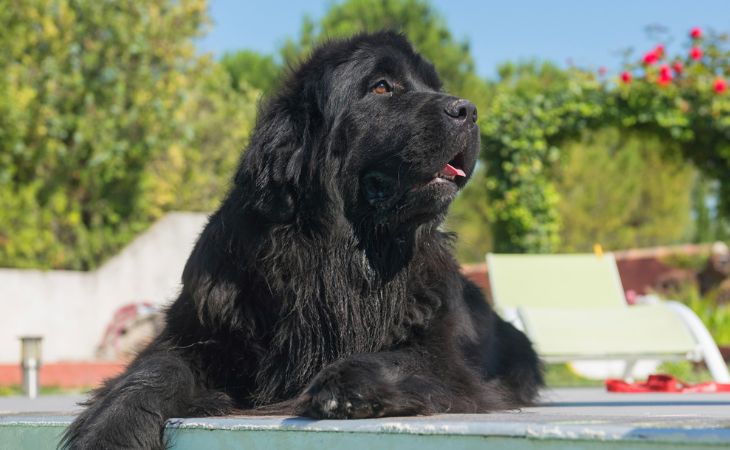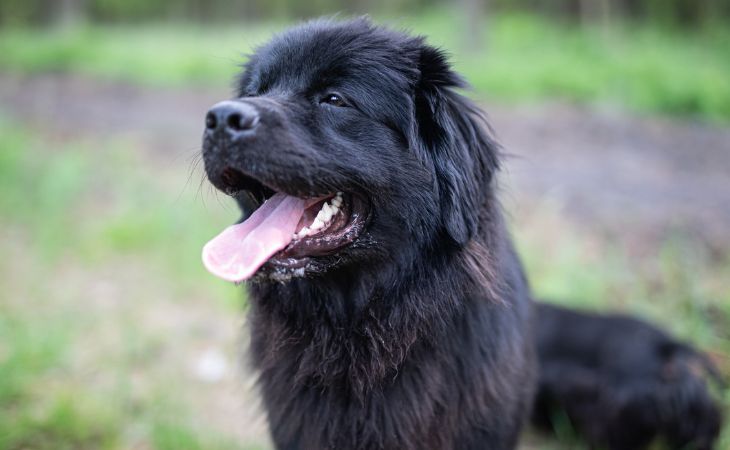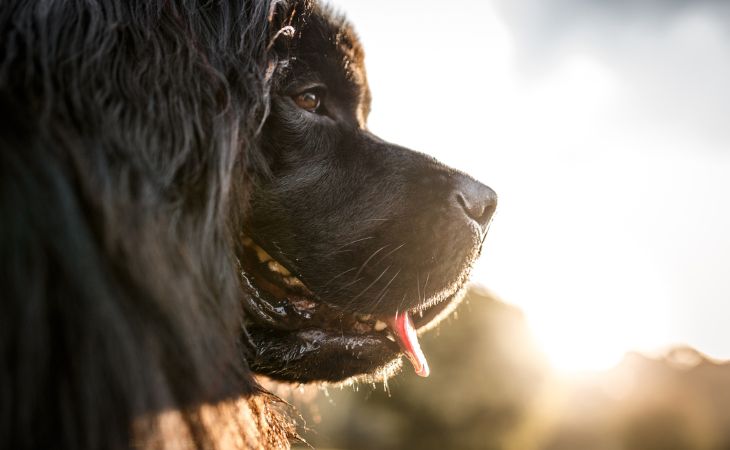Newfoundland breed standard: FCI I Size: Large I Average lifespan: 10+ years I Temperament: Calm, agreeable, peaceful I Coat length: Long I Origin: Unsure.
The Newfoundland dog is a lovable and large dog breed. They are known for being robust like bears and very good swimmers. In the past, they were the best friends of fishermen and were bred and raised as working dogs. This breed’s endurance, strength, and resistance to harsh weather conditions make this breed stand out. In addition, their love for water is a plus for the Newfoundland dog even though they are now bred as companion dogs. In this article, we will give you an overview of the Newfoundland dog’s origins, traits, physical characteristics, and grooming needs.
The origins of the Newfoundland dog
The ancestors of the Newfoundland dog showed a lot of endurance and strength. While this fabulous breed owes its name to the Canadian island of Newfoundland, their origin is still unclear. However, we do know that the Newfoundland dog was appreciated by sailors and fishermen because of their love for the water. This breed was incredibly helpful to them under harsh weather conditions.
Sled dogs and water dogs with unclear origins
The Newfoundland dog would help lift fishnets, carry heavy loads, and take fishing boats out of the water. In addition, these dogs are known for their courage, tirelessness, and enthusiasm. The Newfoundland dog does not hesitate to come to the rescue in dangerous situations such as floods.
Even though the exact origins of the Newfoundland dog are still unknown, it is believed that they came from a cross between the dogs of European fishermen and those of the Beothuk and Mi’kmaq peoples. Then, the local dogs were believed to have been crossed with other European dogs that belonged to sailors and settlers on the island of Newfoundland. The very thick undercoat of the Newfoundland dog can show that the genes might have come from sled dogs in the Arctic.
An excellent working dog that is appreciated throughout all of Europe
The English captain Cartwright described the existence of Newfoundland dogs in his journal, writing that they were admirable for their strength and bravery. The first mentions of the breed can be traced back to the 18th century.
Very quickly, word of these dogs having a reputation as excellent rescue dogs and working dogs spread. In the 19th century, the breed started to piqued the interest of the English and French upper and middle class. This robust dog was also appreciated in Canada and Europe thanks to heroic legends that were told by fishermen.
In 1886, The Newfoundland Club was created and become one of the oldest dog associations. This breeding club was actually the first Newfoundland dog breeding association.
The Newfoundland dog’s character
The Newfoundland dog has a fabulous character. Because these dogs are calm, agreeable, and peaceful, they are truly adorable dogs. Furthermore, the breed is known for its soft look that shows its gentleness and kindness. Overall, the Newfoundland dog breed is a great pet.
An excellent dog for children
Children love the Newfoundland dog. They fascinate people with their patience and attentiveness. Additionally, this large dog is playful. These dogs are also affectionate and loyal with all the members of the family. They like to participate in all sorts of activities and develop a strong bond with their owner.
A breed with a heart of gold despite its intimidating size
Despite their robustness and strength, the Newfoundland dog is anything but aggressive or hostile—even towards strangers. Their imposing physique can sometimes make people think that they are not gentle. These dogs do not bite, they rarely bark, and they will almost never attack anyone.
However, if they know that their family is in danger, they will not hesitate to defend them and protect them. This big bear has a lot of courage and will protect you at all costs.
Above all, the Newfoundland dog is known for its great love for the water and is still appreciated for their water rescue skills. This boat dog is a great swimmer and will feel perfectly at ease in aquatic areas. Also, no matter what the weather conditions are like, the Newfoundland dog loves to swim and will not hesitate to dive in.
This dog need walks outside and loves swimming sessions. Strong winds, rainy weather, or even freezing temperatures will not stop this big bear. Their thick fur will protect them from harsh weather conditions. With that being said, they have a hard time handling hot weather.

The Newfoundland dog’s physical characteristics
General
Their dense coat as well as their thick and soft undercoat explains their passion for water and their inability to handle high temperatures.
Head
This breed has a large skull and a thick neck. The occipital bone is highly developed and the stop is very visible. The Newfoundland dog has a very pigmented nose, developed nostrils, and a muzzle that is rather short and square.
Their eyes are generally dark, deep-set, and quite small.
They have small triangular ears with rounded ends.
Body
With a dense coat, imposing size, gentle look, and impressive mass, the Newfoundland dog looks like a bear. Adult females measure 66 cm (≈ 2.2 ft) at the withers and the males measure 71 cm (≈ 2.3 ft). Females appear less imposing than males and have a body that is more elongated. Males weigh around 70 kg (≈ 154.3 lb) and females weigh around 56 kg (≈ 123.5 lb).
With a large back and muscular loin, the chest of the Newfoundland dog is well-developed and rather large.
Coat, color, and grooming
Coat
This breed has a dense and coarse coat. They have a double coat, which keeps them protected from the water.
Colors
The muscular and massive body of the Newfoundland dog can be black, brown, or white and black. The black tones are the most common and need to be as uniform as possible. However, the black and white color has been very important historically speaking. It has contributed to the development of the Landseer dog breed.
The brown color does not correspond to the breed standard in Canada. They can range from brown to chestnut. For black and brown dogs, white marks around the chest and paws as well as on the end of their tail are accepted.

Grooming and care
The breed is robust and resists well to harsh weather conditions. The wind, cold, or rain does not bother this dog. However, they are not very comfortable under the sun. The Newfoundland is in fact more accustomed to the harsh climates of Canada and does not handle the summer and elevated temperatures very well.
The dense coat of the Newfoundland needs to be groomed daily. This is to prevent the coat from getting tangled. With that being said, it’s best to avoid combs because they can pull out the hairs and can even hurt these dogs. Keep in mind that the ears and eyes also require regular care. When it comes to this breed’s teeth, bones for chewing are an excellent solution.
The Newfoundland is a furry dog that needs particular care. For example, they truly love nature and are therefore not a good match for people who prefer to stay at home. They need to exercise, get out, and swim. Because of this, this breed is not well-suited to city life. They like long walks in the nature, around a lake, or by the sea. Lastly, this large dog is very affectionate and ideal for active families that are looking for a pet to take with them on their adventures.
Do you like large dog breeds? You can learn more about them in this article.
The Newfoundland dog at a glance
Size: at the withers, the Newfoundland measures 66 to 71 cm (≈ 2.2 to 2.3 ft).
Weight: 56 to 70 kg (≈ 123.5 to 154.3 lb).
Health: The Newfoundland dog has robust health. However, they can be prone to hip and elbow dysplasia. Because of their double coat, this breed is also sensitive to high temperatures.
Average lifespan: 10 years.
Are Newfoundland dogs good with children? Never aggressive and always joyful, this is a marvelous dog for families with children.
Are Newfoundland dogs easy to train? Because of their size and sensitivity, the Newfoundland dog needs to be trained early to temper their impulses, especially when they are young and do not realize their size.

